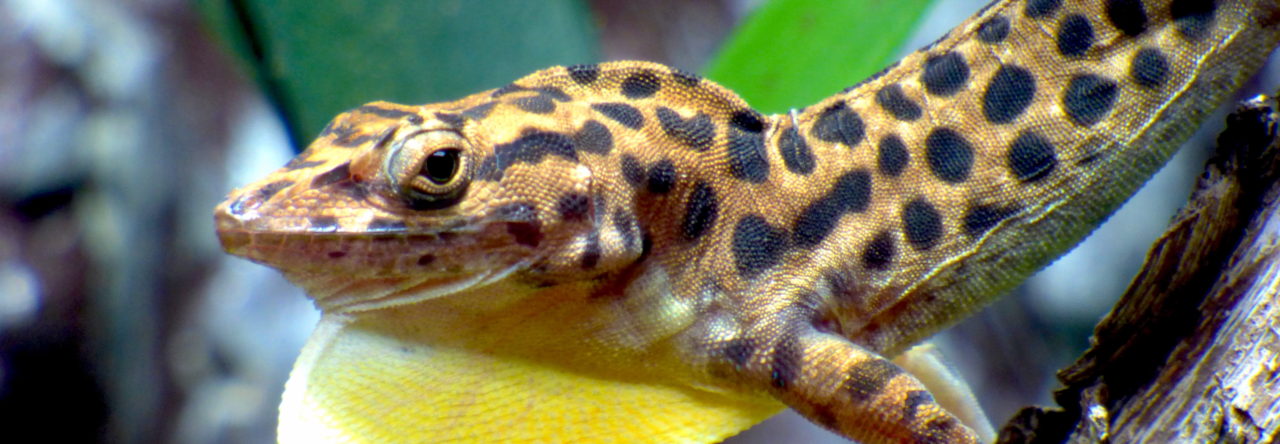When it comes to territorial behavior male anoles tend to get all the attention. I suppose it makes sense – nothing catches the eye like a brightly colored male doing a few dewlap extensions or engaging in a dramatic battle. It would be a bit of an understatement to say that we like to talk about male-male territoriality and aggressive encounters on this blog (1, 2, 3, 4, 5, 6, and the list goes on!). In fact, we’ve even had photo contests to document the best fights, which tend to feature large, colorful males.
Perhaps it’s no surprise, but females can be just as aggressive as males. At SICB this past January, I learned about Jessica Edward’s research on aggressive encounters between Anolis carolinensis and A. sagrei. It turns out that the victor of female-female staged encounters was nearly always A. sagrei. There are plenty of interesting papers on the topic, for those that are interested (1, 2, among others).
Regardless, I was completely caught off guard during my field expedition last summer to the Dominican Republic when a female A. armouri engaged in a territorial display against a male intruder. Along with Ellee Cook, an undergraduate at Trinity, I was catching A. armouri near Loma de Toro high in the Sierra de Baoruco, the mountain chain that runs between Haiti and the Dominican Republic in the southwest of the island. It’s frequently rainy and overcast at these high elevations and we spent most of our time languishing in the drizzle and waiting for the lizards emerge, as evidenced in Figure 1 and Figure 2.

Figure 2. Ellee Cook in Loma de Toro. The sun had come out and the lizards were active, but the male hiding in this stump eluded her for hours.
In a rare moment of sunshine we witnessed a mass exodus of lizards from their retreat sites under logs and rocks. All of a sudden, we had more work than we could keep up with and we tried to noose as many lizards as possible. We had one lizard tied on a noose, which we set down on the ground so that we could quickly catch another that had suddenly emerged. Little did we know that we dropped the male near the territory of another male A. armouri who was not remotely amused by the sudden appearance of an intruder. He quickly popped out from underneath a stump and began vigorously displaying at our leashed quarry (Fig. 3). We stopped our work to grab the noosed anole before any harm could befall him, but were stopped in our tracks when, out of nowhere, a large female came out, still cool and dark-colored from her retreat site, and began displaying at the intruder (Fig. 4).
The female headbobbed several times and, perhaps most intriguingly, extended and shook her dewlap at him. Let me clarify – I have seen female anoles display before. In fact, I spent a summer watching A. marmoratus females dewlap at brightly colored suitors. This A. armouri, however, was distinctly different. She extended her dewlap once and then headbobbed vigorously at the male, rather than perform a mix of dewlaps and headbobs. It looked like someone angrily shaking a beard, and was equally ridiculous.
I left feeling tickled and baffled. I certainly would expect females to be quite territorial towards each other, but what fascinated me was that this female was exhibiting aggression towards a male. I would have been inclined to think that the females leave those battles up to the males. I suppose females would compete for shared resources with a male as much as with a female, and so it may not be so unusual for her to exhibit territoriality. However, any territorial encounter that escalated into a fight would tend to end badly for the females, as they are considerably smaller than the males. It seems unlikely to me that she was expressing sexual interest towards the male, as the encounter seemed very aggressive. Any thoughts on why this happens?
- SICB 2018: Revisiting the Fitch-Hillis Hypothesis in Mexican Anoles - January 8, 2018
- Evolution 2017: Urban Anoles Sprint Faster on Smooth Substrates - June 26, 2017
- SICB 2017: New Insights into Pre- and Postcopulatory Selection in Anoles - January 10, 2017






Skip (James) Lazell
After nearly 70 years of paying attention to anoles I do not remember ever once seeing a female behave aggressively towards any other anole. Lucky you! Skip
Rich Glor
Perhaps quality shelters, basking sites and territories are at a premium in A. armouri habitat and females are willing to risk combat (or at least bluff) to defend them?